MICE Sector Green Event Planning: Proposal for Sustainable Tourism
VerifiedAdded on 2023/06/12
|13
|3123
|403
Report
AI Summary
This report presents a proposal for a sustainable tourism conference within the Meetings, Incentives, Conferences, and Exhibitions (MICE) sector, emphasizing green event planning and corporate social responsibility. It includes a literature review highlighting the importance of environmental sustainability in tourism and the growing trend of 'going green.' The proposal outlines a marketing plan focused on environmentally friendly methods, venue recommendations (Melia Kuala Lumpur), catering with sustainable food options, and transportation via bus to minimize emissions. Keynote speakers will be researchers and professionals in renewable energy, with conference themes centered around green materials, technologies, and smart energy solutions. The itinerary spans three days and incorporates lectures, networking events, and workshops, with careful attention paid to minimizing noise levels and waste. A tentative budget is provided, outlining expected expenses and revenue generation. This plan aims to promote environmental awareness, minimize environmental impact, and ensure a successful and sustainable conference.
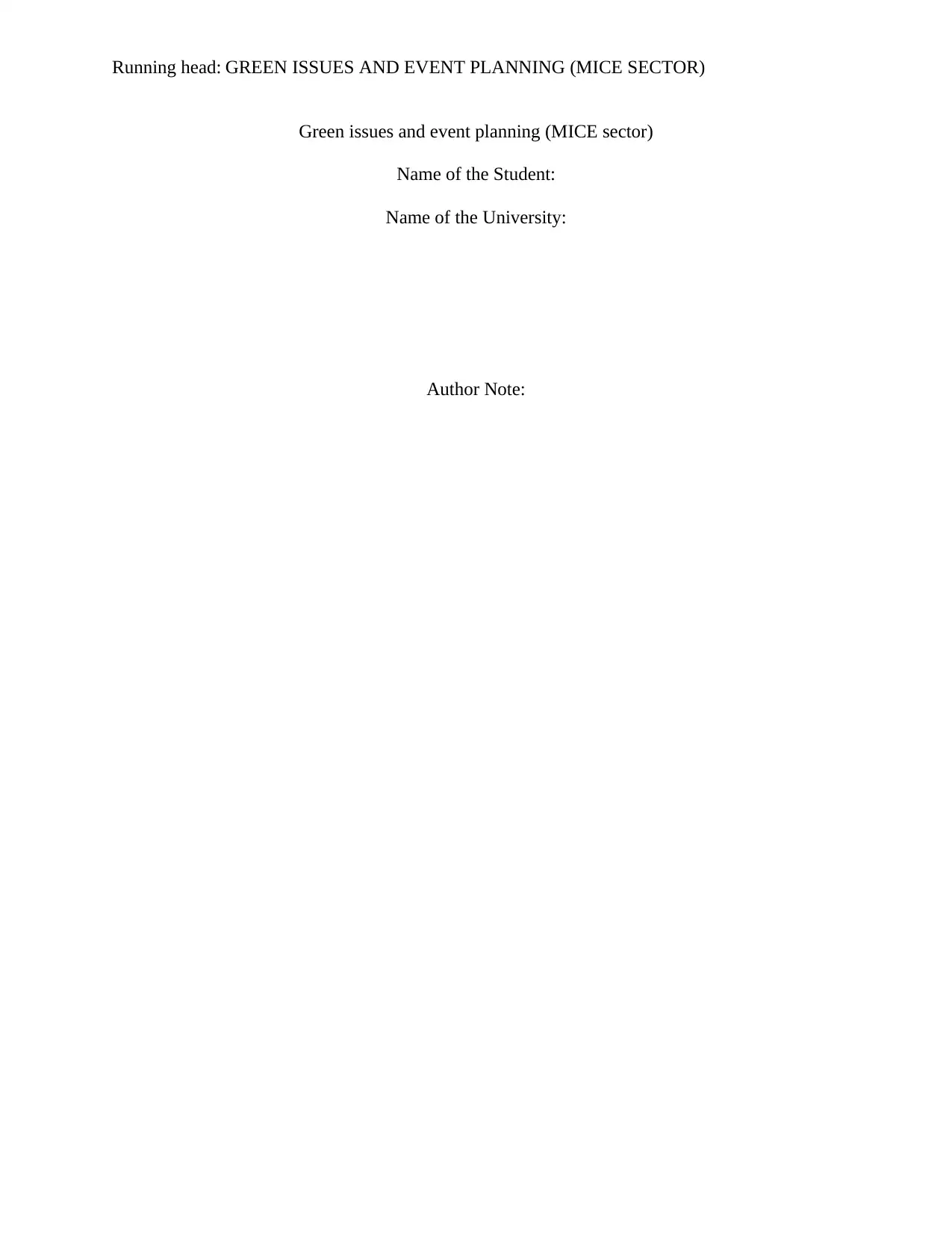
Running head: GREEN ISSUES AND EVENT PLANNING (MICE SECTOR)
Green issues and event planning (MICE sector)
Name of the Student:
Name of the University:
Author Note:
Green issues and event planning (MICE sector)
Name of the Student:
Name of the University:
Author Note:
Paraphrase This Document
Need a fresh take? Get an instant paraphrase of this document with our AI Paraphraser
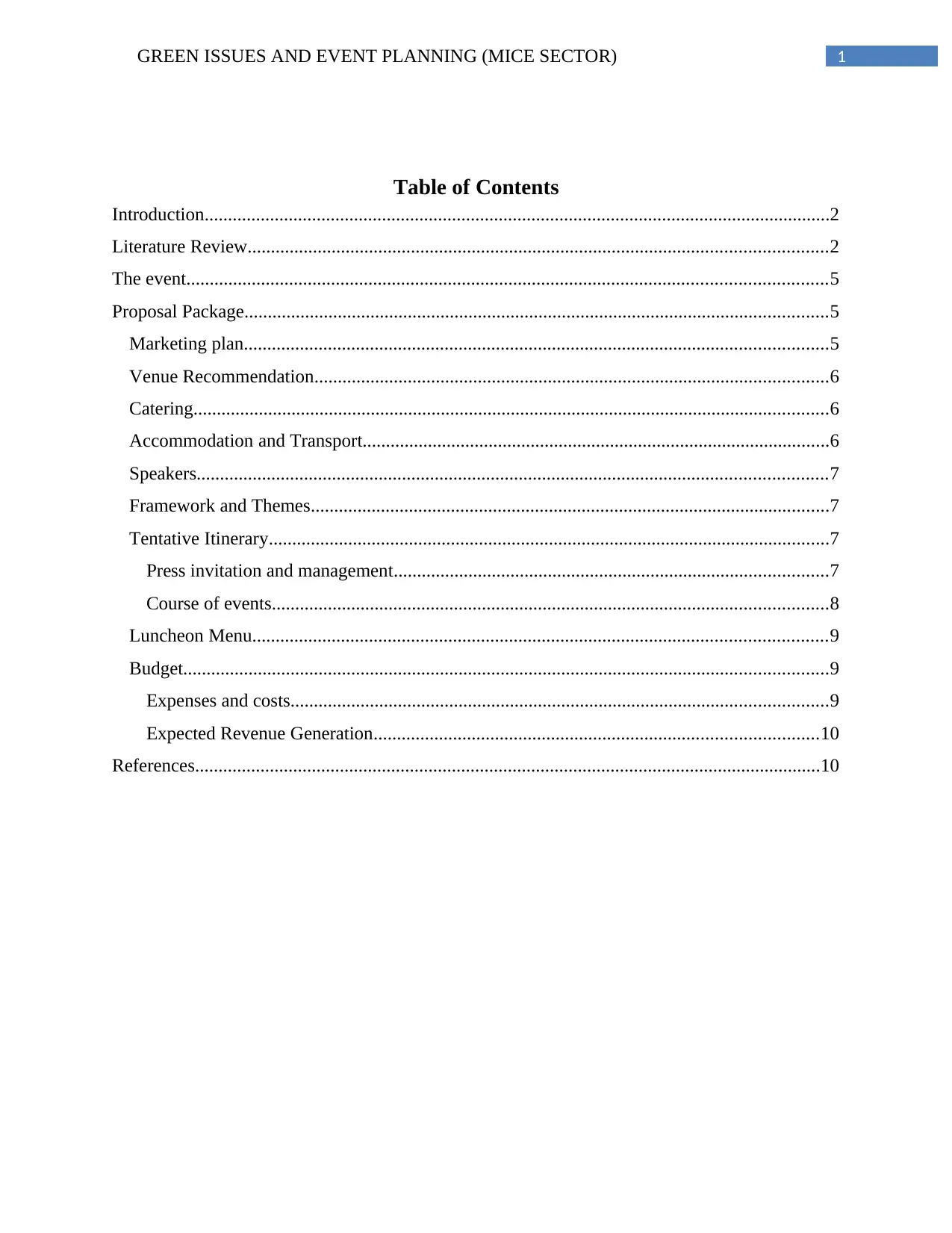
1GREEN ISSUES AND EVENT PLANNING (MICE SECTOR)
Table of Contents
Introduction......................................................................................................................................2
Literature Review............................................................................................................................2
The event.........................................................................................................................................5
Proposal Package.............................................................................................................................5
Marketing plan.............................................................................................................................5
Venue Recommendation..............................................................................................................6
Catering........................................................................................................................................6
Accommodation and Transport....................................................................................................6
Speakers.......................................................................................................................................7
Framework and Themes...............................................................................................................7
Tentative Itinerary........................................................................................................................7
Press invitation and management.............................................................................................7
Course of events.......................................................................................................................8
Luncheon Menu...........................................................................................................................9
Budget..........................................................................................................................................9
Expenses and costs...................................................................................................................9
Expected Revenue Generation...............................................................................................10
References......................................................................................................................................10
Table of Contents
Introduction......................................................................................................................................2
Literature Review............................................................................................................................2
The event.........................................................................................................................................5
Proposal Package.............................................................................................................................5
Marketing plan.............................................................................................................................5
Venue Recommendation..............................................................................................................6
Catering........................................................................................................................................6
Accommodation and Transport....................................................................................................6
Speakers.......................................................................................................................................7
Framework and Themes...............................................................................................................7
Tentative Itinerary........................................................................................................................7
Press invitation and management.............................................................................................7
Course of events.......................................................................................................................8
Luncheon Menu...........................................................................................................................9
Budget..........................................................................................................................................9
Expenses and costs...................................................................................................................9
Expected Revenue Generation...............................................................................................10
References......................................................................................................................................10
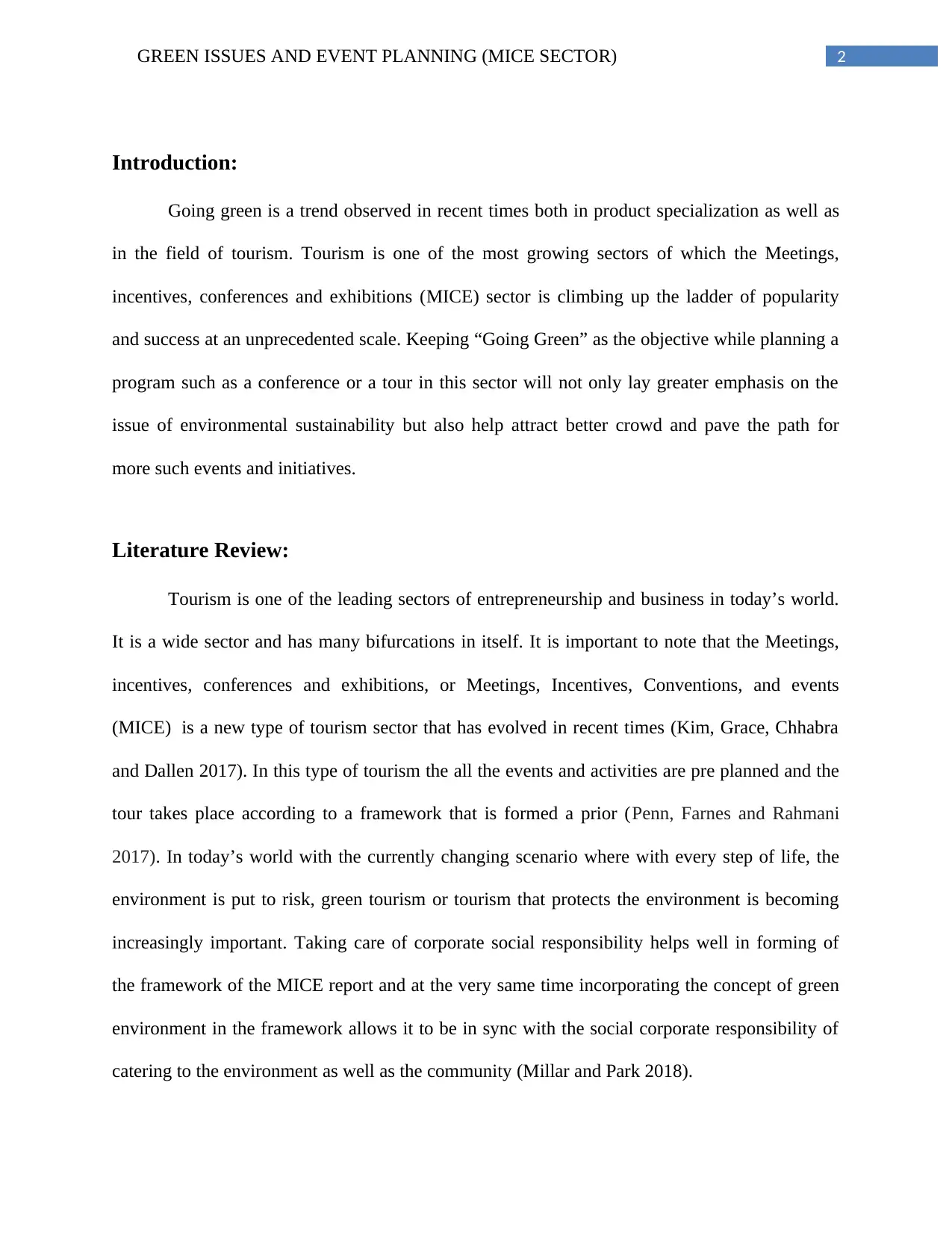
2GREEN ISSUES AND EVENT PLANNING (MICE SECTOR)
Introduction:
Going green is a trend observed in recent times both in product specialization as well as
in the field of tourism. Tourism is one of the most growing sectors of which the Meetings,
incentives, conferences and exhibitions (MICE) sector is climbing up the ladder of popularity
and success at an unprecedented scale. Keeping “Going Green” as the objective while planning a
program such as a conference or a tour in this sector will not only lay greater emphasis on the
issue of environmental sustainability but also help attract better crowd and pave the path for
more such events and initiatives.
Literature Review:
Tourism is one of the leading sectors of entrepreneurship and business in today’s world.
It is a wide sector and has many bifurcations in itself. It is important to note that the Meetings,
incentives, conferences and exhibitions, or Meetings, Incentives, Conventions, and events
(MICE) is a new type of tourism sector that has evolved in recent times (Kim, Grace, Chhabra
and Dallen 2017). In this type of tourism the all the events and activities are pre planned and the
tour takes place according to a framework that is formed a prior (Penn, Farnes and Rahmani
2017). In today’s world with the currently changing scenario where with every step of life, the
environment is put to risk, green tourism or tourism that protects the environment is becoming
increasingly important. Taking care of corporate social responsibility helps well in forming of
the framework of the MICE report and at the very same time incorporating the concept of green
environment in the framework allows it to be in sync with the social corporate responsibility of
catering to the environment as well as the community (Millar and Park 2018).
Introduction:
Going green is a trend observed in recent times both in product specialization as well as
in the field of tourism. Tourism is one of the most growing sectors of which the Meetings,
incentives, conferences and exhibitions (MICE) sector is climbing up the ladder of popularity
and success at an unprecedented scale. Keeping “Going Green” as the objective while planning a
program such as a conference or a tour in this sector will not only lay greater emphasis on the
issue of environmental sustainability but also help attract better crowd and pave the path for
more such events and initiatives.
Literature Review:
Tourism is one of the leading sectors of entrepreneurship and business in today’s world.
It is a wide sector and has many bifurcations in itself. It is important to note that the Meetings,
incentives, conferences and exhibitions, or Meetings, Incentives, Conventions, and events
(MICE) is a new type of tourism sector that has evolved in recent times (Kim, Grace, Chhabra
and Dallen 2017). In this type of tourism the all the events and activities are pre planned and the
tour takes place according to a framework that is formed a prior (Penn, Farnes and Rahmani
2017). In today’s world with the currently changing scenario where with every step of life, the
environment is put to risk, green tourism or tourism that protects the environment is becoming
increasingly important. Taking care of corporate social responsibility helps well in forming of
the framework of the MICE report and at the very same time incorporating the concept of green
environment in the framework allows it to be in sync with the social corporate responsibility of
catering to the environment as well as the community (Millar and Park 2018).
You're viewing a preview
Unlock full access by subscribing today!
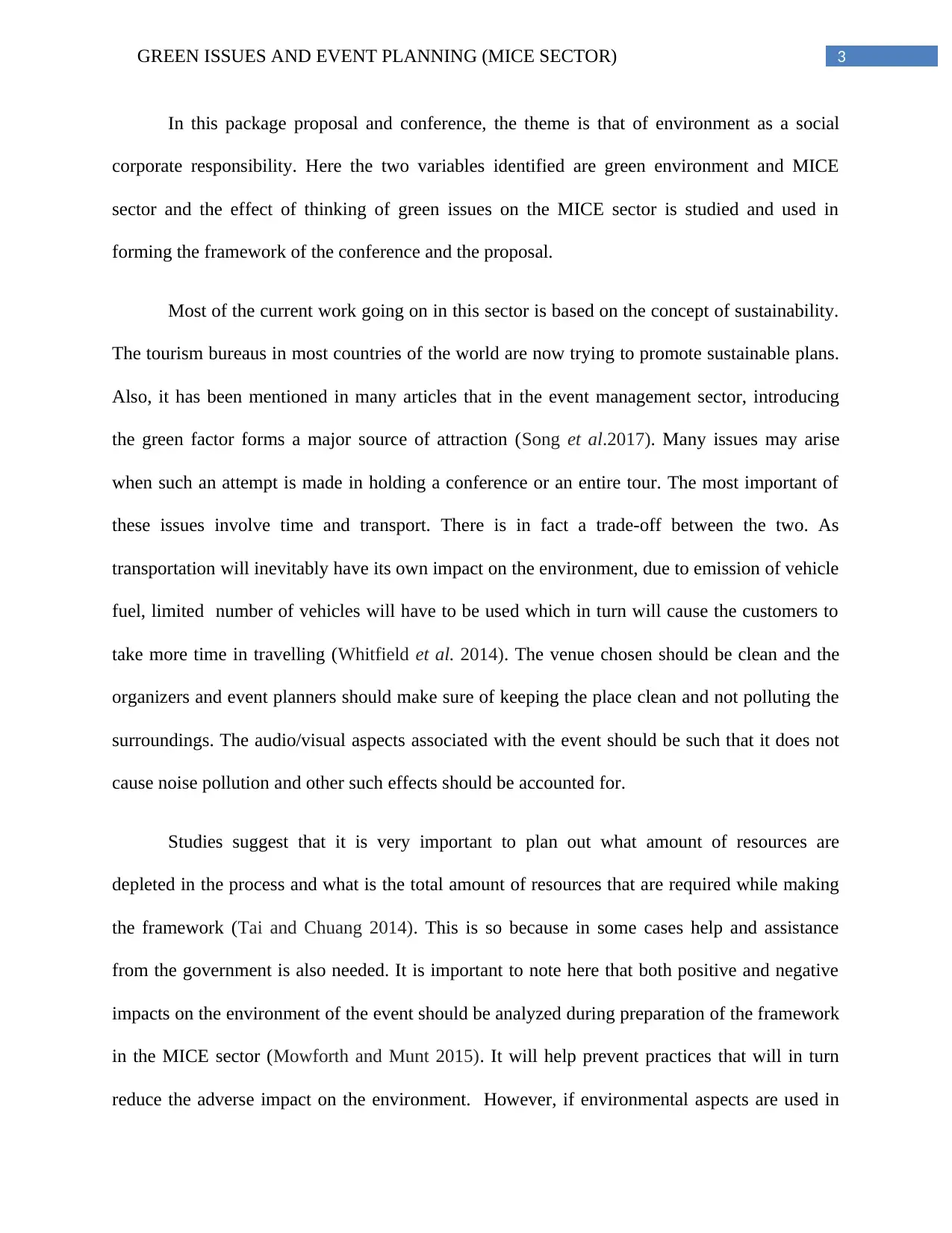
3GREEN ISSUES AND EVENT PLANNING (MICE SECTOR)
In this package proposal and conference, the theme is that of environment as a social
corporate responsibility. Here the two variables identified are green environment and MICE
sector and the effect of thinking of green issues on the MICE sector is studied and used in
forming the framework of the conference and the proposal.
Most of the current work going on in this sector is based on the concept of sustainability.
The tourism bureaus in most countries of the world are now trying to promote sustainable plans.
Also, it has been mentioned in many articles that in the event management sector, introducing
the green factor forms a major source of attraction (Song et al.2017). Many issues may arise
when such an attempt is made in holding a conference or an entire tour. The most important of
these issues involve time and transport. There is in fact a trade-off between the two. As
transportation will inevitably have its own impact on the environment, due to emission of vehicle
fuel, limited number of vehicles will have to be used which in turn will cause the customers to
take more time in travelling (Whitfield et al. 2014). The venue chosen should be clean and the
organizers and event planners should make sure of keeping the place clean and not polluting the
surroundings. The audio/visual aspects associated with the event should be such that it does not
cause noise pollution and other such effects should be accounted for.
Studies suggest that it is very important to plan out what amount of resources are
depleted in the process and what is the total amount of resources that are required while making
the framework (Tai and Chuang 2014). This is so because in some cases help and assistance
from the government is also needed. It is important to note here that both positive and negative
impacts on the environment of the event should be analyzed during preparation of the framework
in the MICE sector (Mowforth and Munt 2015). It will help prevent practices that will in turn
reduce the adverse impact on the environment. However, if environmental aspects are used in
In this package proposal and conference, the theme is that of environment as a social
corporate responsibility. Here the two variables identified are green environment and MICE
sector and the effect of thinking of green issues on the MICE sector is studied and used in
forming the framework of the conference and the proposal.
Most of the current work going on in this sector is based on the concept of sustainability.
The tourism bureaus in most countries of the world are now trying to promote sustainable plans.
Also, it has been mentioned in many articles that in the event management sector, introducing
the green factor forms a major source of attraction (Song et al.2017). Many issues may arise
when such an attempt is made in holding a conference or an entire tour. The most important of
these issues involve time and transport. There is in fact a trade-off between the two. As
transportation will inevitably have its own impact on the environment, due to emission of vehicle
fuel, limited number of vehicles will have to be used which in turn will cause the customers to
take more time in travelling (Whitfield et al. 2014). The venue chosen should be clean and the
organizers and event planners should make sure of keeping the place clean and not polluting the
surroundings. The audio/visual aspects associated with the event should be such that it does not
cause noise pollution and other such effects should be accounted for.
Studies suggest that it is very important to plan out what amount of resources are
depleted in the process and what is the total amount of resources that are required while making
the framework (Tai and Chuang 2014). This is so because in some cases help and assistance
from the government is also needed. It is important to note here that both positive and negative
impacts on the environment of the event should be analyzed during preparation of the framework
in the MICE sector (Mowforth and Munt 2015). It will help prevent practices that will in turn
reduce the adverse impact on the environment. However, if environmental aspects are used in
Paraphrase This Document
Need a fresh take? Get an instant paraphrase of this document with our AI Paraphraser
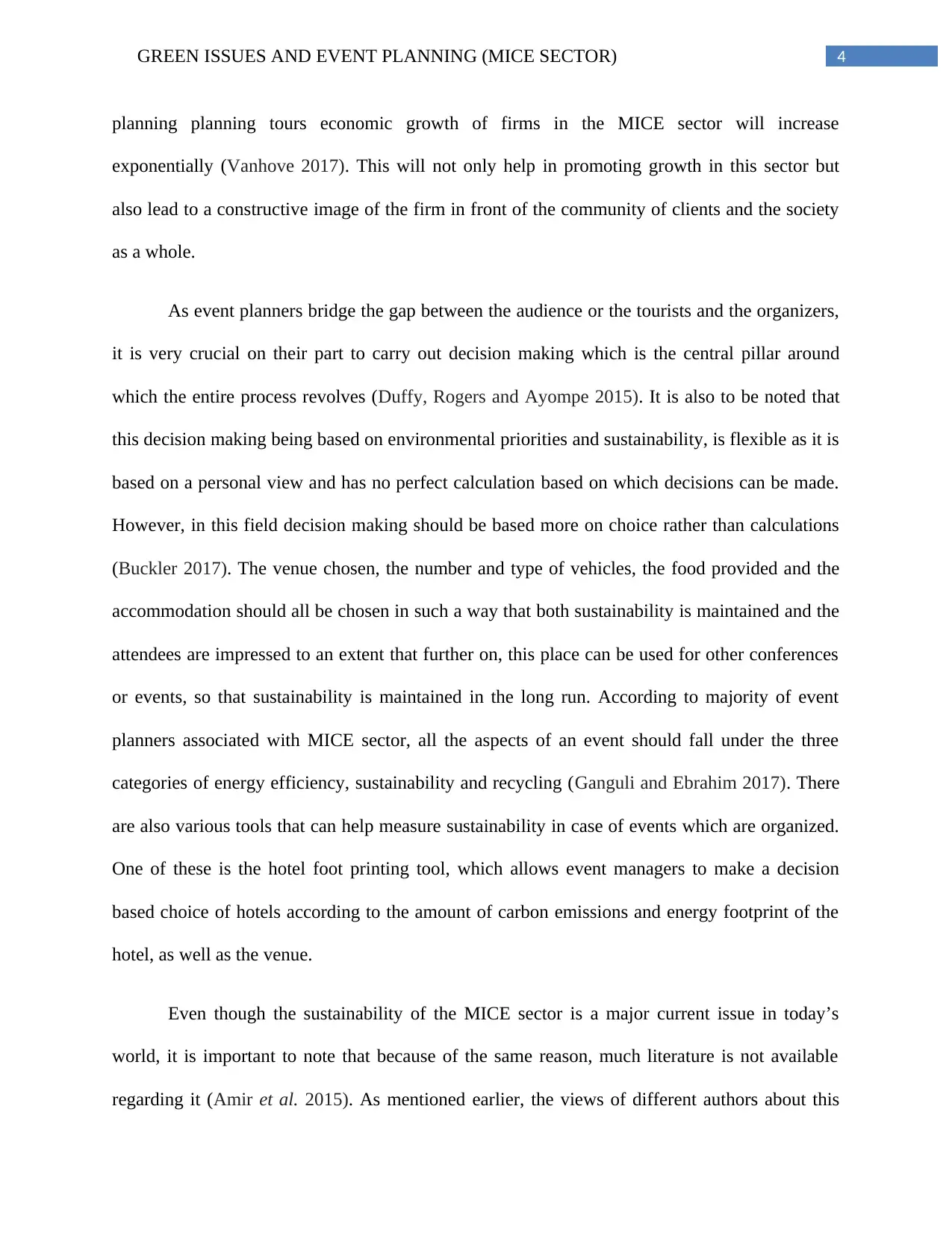
4GREEN ISSUES AND EVENT PLANNING (MICE SECTOR)
planning planning tours economic growth of firms in the MICE sector will increase
exponentially (Vanhove 2017). This will not only help in promoting growth in this sector but
also lead to a constructive image of the firm in front of the community of clients and the society
as a whole.
As event planners bridge the gap between the audience or the tourists and the organizers,
it is very crucial on their part to carry out decision making which is the central pillar around
which the entire process revolves (Duffy, Rogers and Ayompe 2015). It is also to be noted that
this decision making being based on environmental priorities and sustainability, is flexible as it is
based on a personal view and has no perfect calculation based on which decisions can be made.
However, in this field decision making should be based more on choice rather than calculations
(Buckler 2017). The venue chosen, the number and type of vehicles, the food provided and the
accommodation should all be chosen in such a way that both sustainability is maintained and the
attendees are impressed to an extent that further on, this place can be used for other conferences
or events, so that sustainability is maintained in the long run. According to majority of event
planners associated with MICE sector, all the aspects of an event should fall under the three
categories of energy efficiency, sustainability and recycling (Ganguli and Ebrahim 2017). There
are also various tools that can help measure sustainability in case of events which are organized.
One of these is the hotel foot printing tool, which allows event managers to make a decision
based choice of hotels according to the amount of carbon emissions and energy footprint of the
hotel, as well as the venue.
Even though the sustainability of the MICE sector is a major current issue in today’s
world, it is important to note that because of the same reason, much literature is not available
regarding it (Amir et al. 2015). As mentioned earlier, the views of different authors about this
planning planning tours economic growth of firms in the MICE sector will increase
exponentially (Vanhove 2017). This will not only help in promoting growth in this sector but
also lead to a constructive image of the firm in front of the community of clients and the society
as a whole.
As event planners bridge the gap between the audience or the tourists and the organizers,
it is very crucial on their part to carry out decision making which is the central pillar around
which the entire process revolves (Duffy, Rogers and Ayompe 2015). It is also to be noted that
this decision making being based on environmental priorities and sustainability, is flexible as it is
based on a personal view and has no perfect calculation based on which decisions can be made.
However, in this field decision making should be based more on choice rather than calculations
(Buckler 2017). The venue chosen, the number and type of vehicles, the food provided and the
accommodation should all be chosen in such a way that both sustainability is maintained and the
attendees are impressed to an extent that further on, this place can be used for other conferences
or events, so that sustainability is maintained in the long run. According to majority of event
planners associated with MICE sector, all the aspects of an event should fall under the three
categories of energy efficiency, sustainability and recycling (Ganguli and Ebrahim 2017). There
are also various tools that can help measure sustainability in case of events which are organized.
One of these is the hotel foot printing tool, which allows event managers to make a decision
based choice of hotels according to the amount of carbon emissions and energy footprint of the
hotel, as well as the venue.
Even though the sustainability of the MICE sector is a major current issue in today’s
world, it is important to note that because of the same reason, much literature is not available
regarding it (Amir et al. 2015). As mentioned earlier, the views of different authors about this
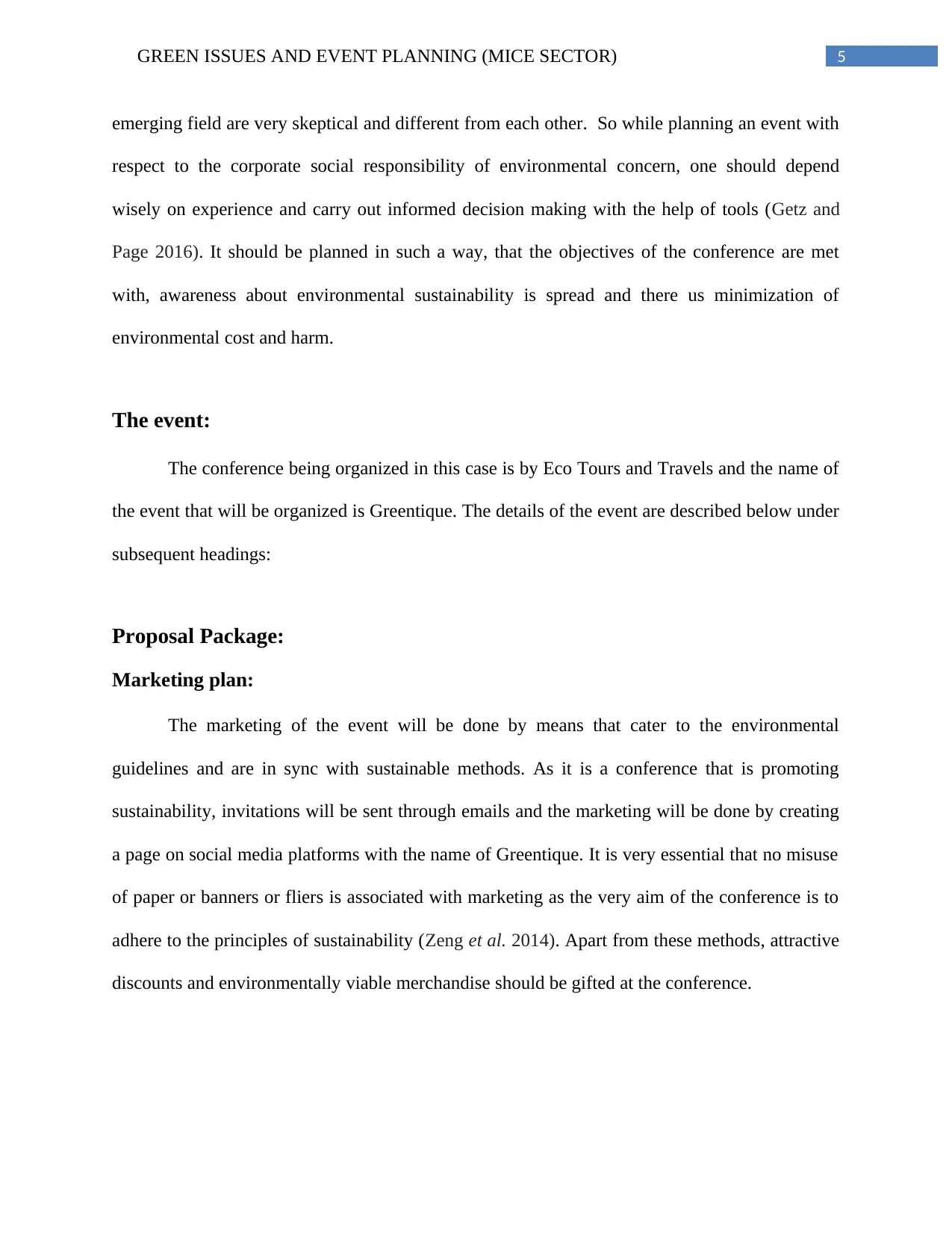
5GREEN ISSUES AND EVENT PLANNING (MICE SECTOR)
emerging field are very skeptical and different from each other. So while planning an event with
respect to the corporate social responsibility of environmental concern, one should depend
wisely on experience and carry out informed decision making with the help of tools (Getz and
Page 2016). It should be planned in such a way, that the objectives of the conference are met
with, awareness about environmental sustainability is spread and there us minimization of
environmental cost and harm.
The event:
The conference being organized in this case is by Eco Tours and Travels and the name of
the event that will be organized is Greentique. The details of the event are described below under
subsequent headings:
Proposal Package:
Marketing plan:
The marketing of the event will be done by means that cater to the environmental
guidelines and are in sync with sustainable methods. As it is a conference that is promoting
sustainability, invitations will be sent through emails and the marketing will be done by creating
a page on social media platforms with the name of Greentique. It is very essential that no misuse
of paper or banners or fliers is associated with marketing as the very aim of the conference is to
adhere to the principles of sustainability (Zeng et al. 2014). Apart from these methods, attractive
discounts and environmentally viable merchandise should be gifted at the conference.
emerging field are very skeptical and different from each other. So while planning an event with
respect to the corporate social responsibility of environmental concern, one should depend
wisely on experience and carry out informed decision making with the help of tools (Getz and
Page 2016). It should be planned in such a way, that the objectives of the conference are met
with, awareness about environmental sustainability is spread and there us minimization of
environmental cost and harm.
The event:
The conference being organized in this case is by Eco Tours and Travels and the name of
the event that will be organized is Greentique. The details of the event are described below under
subsequent headings:
Proposal Package:
Marketing plan:
The marketing of the event will be done by means that cater to the environmental
guidelines and are in sync with sustainable methods. As it is a conference that is promoting
sustainability, invitations will be sent through emails and the marketing will be done by creating
a page on social media platforms with the name of Greentique. It is very essential that no misuse
of paper or banners or fliers is associated with marketing as the very aim of the conference is to
adhere to the principles of sustainability (Zeng et al. 2014). Apart from these methods, attractive
discounts and environmentally viable merchandise should be gifted at the conference.
You're viewing a preview
Unlock full access by subscribing today!
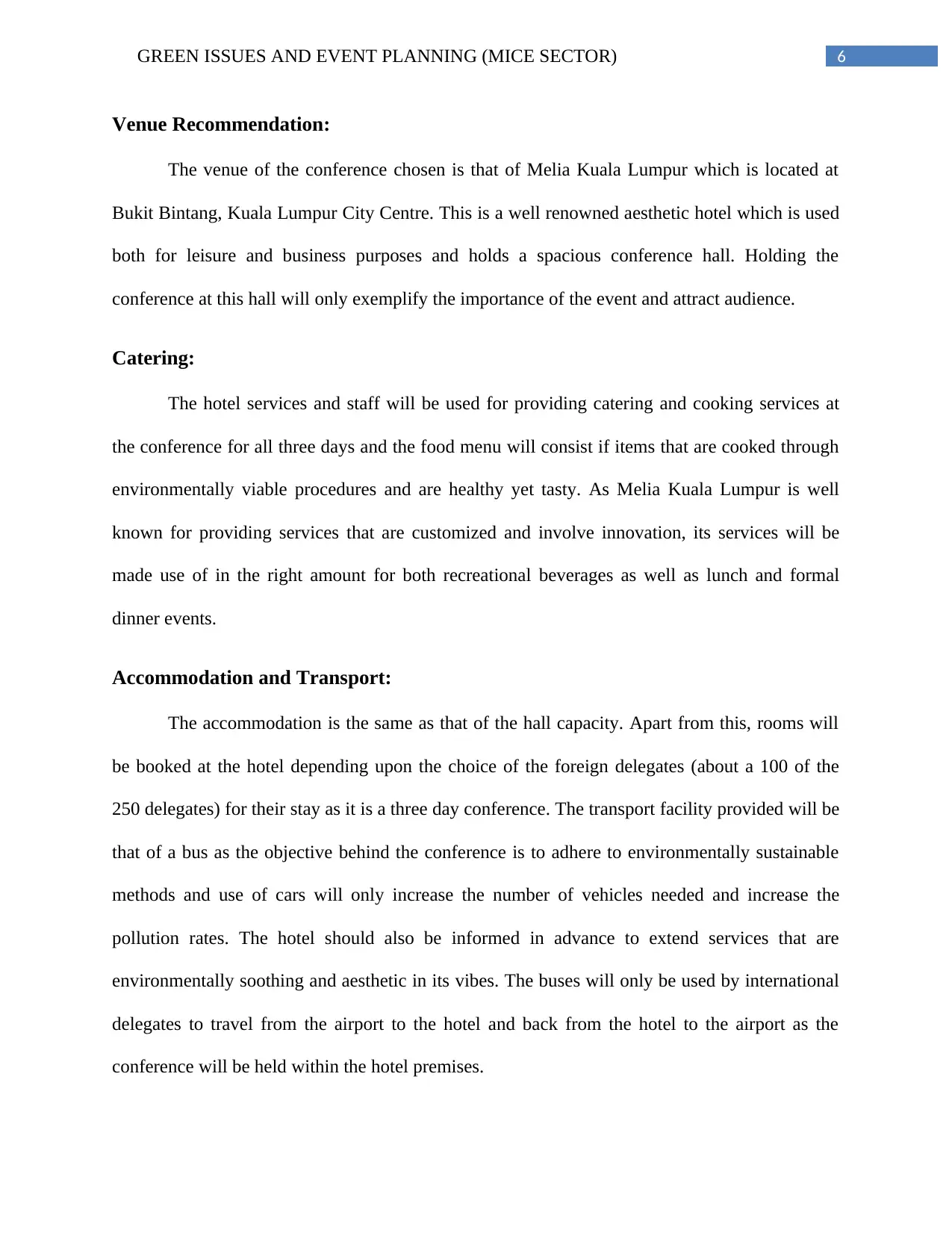
6GREEN ISSUES AND EVENT PLANNING (MICE SECTOR)
Venue Recommendation:
The venue of the conference chosen is that of Melia Kuala Lumpur which is located at
Bukit Bintang, Kuala Lumpur City Centre. This is a well renowned aesthetic hotel which is used
both for leisure and business purposes and holds a spacious conference hall. Holding the
conference at this hall will only exemplify the importance of the event and attract audience.
Catering:
The hotel services and staff will be used for providing catering and cooking services at
the conference for all three days and the food menu will consist if items that are cooked through
environmentally viable procedures and are healthy yet tasty. As Melia Kuala Lumpur is well
known for providing services that are customized and involve innovation, its services will be
made use of in the right amount for both recreational beverages as well as lunch and formal
dinner events.
Accommodation and Transport:
The accommodation is the same as that of the hall capacity. Apart from this, rooms will
be booked at the hotel depending upon the choice of the foreign delegates (about a 100 of the
250 delegates) for their stay as it is a three day conference. The transport facility provided will be
that of a bus as the objective behind the conference is to adhere to environmentally sustainable
methods and use of cars will only increase the number of vehicles needed and increase the
pollution rates. The hotel should also be informed in advance to extend services that are
environmentally soothing and aesthetic in its vibes. The buses will only be used by international
delegates to travel from the airport to the hotel and back from the hotel to the airport as the
conference will be held within the hotel premises.
Venue Recommendation:
The venue of the conference chosen is that of Melia Kuala Lumpur which is located at
Bukit Bintang, Kuala Lumpur City Centre. This is a well renowned aesthetic hotel which is used
both for leisure and business purposes and holds a spacious conference hall. Holding the
conference at this hall will only exemplify the importance of the event and attract audience.
Catering:
The hotel services and staff will be used for providing catering and cooking services at
the conference for all three days and the food menu will consist if items that are cooked through
environmentally viable procedures and are healthy yet tasty. As Melia Kuala Lumpur is well
known for providing services that are customized and involve innovation, its services will be
made use of in the right amount for both recreational beverages as well as lunch and formal
dinner events.
Accommodation and Transport:
The accommodation is the same as that of the hall capacity. Apart from this, rooms will
be booked at the hotel depending upon the choice of the foreign delegates (about a 100 of the
250 delegates) for their stay as it is a three day conference. The transport facility provided will be
that of a bus as the objective behind the conference is to adhere to environmentally sustainable
methods and use of cars will only increase the number of vehicles needed and increase the
pollution rates. The hotel should also be informed in advance to extend services that are
environmentally soothing and aesthetic in its vibes. The buses will only be used by international
delegates to travel from the airport to the hotel and back from the hotel to the airport as the
conference will be held within the hotel premises.
Paraphrase This Document
Need a fresh take? Get an instant paraphrase of this document with our AI Paraphraser
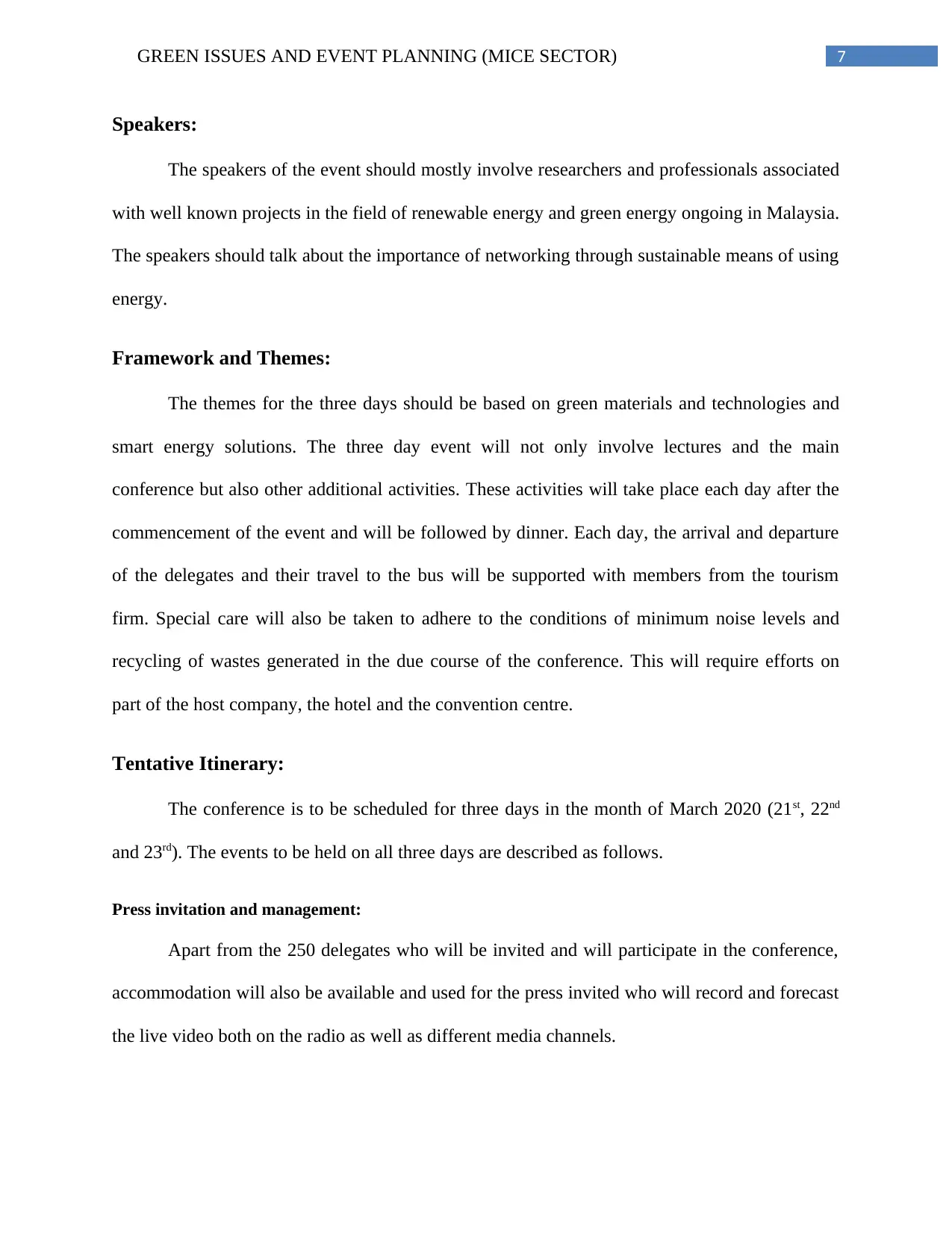
7GREEN ISSUES AND EVENT PLANNING (MICE SECTOR)
Speakers:
The speakers of the event should mostly involve researchers and professionals associated
with well known projects in the field of renewable energy and green energy ongoing in Malaysia.
The speakers should talk about the importance of networking through sustainable means of using
energy.
Framework and Themes:
The themes for the three days should be based on green materials and technologies and
smart energy solutions. The three day event will not only involve lectures and the main
conference but also other additional activities. These activities will take place each day after the
commencement of the event and will be followed by dinner. Each day, the arrival and departure
of the delegates and their travel to the bus will be supported with members from the tourism
firm. Special care will also be taken to adhere to the conditions of minimum noise levels and
recycling of wastes generated in the due course of the conference. This will require efforts on
part of the host company, the hotel and the convention centre.
Tentative Itinerary:
The conference is to be scheduled for three days in the month of March 2020 (21st, 22nd
and 23rd). The events to be held on all three days are described as follows.
Press invitation and management:
Apart from the 250 delegates who will be invited and will participate in the conference,
accommodation will also be available and used for the press invited who will record and forecast
the live video both on the radio as well as different media channels.
Speakers:
The speakers of the event should mostly involve researchers and professionals associated
with well known projects in the field of renewable energy and green energy ongoing in Malaysia.
The speakers should talk about the importance of networking through sustainable means of using
energy.
Framework and Themes:
The themes for the three days should be based on green materials and technologies and
smart energy solutions. The three day event will not only involve lectures and the main
conference but also other additional activities. These activities will take place each day after the
commencement of the event and will be followed by dinner. Each day, the arrival and departure
of the delegates and their travel to the bus will be supported with members from the tourism
firm. Special care will also be taken to adhere to the conditions of minimum noise levels and
recycling of wastes generated in the due course of the conference. This will require efforts on
part of the host company, the hotel and the convention centre.
Tentative Itinerary:
The conference is to be scheduled for three days in the month of March 2020 (21st, 22nd
and 23rd). The events to be held on all three days are described as follows.
Press invitation and management:
Apart from the 250 delegates who will be invited and will participate in the conference,
accommodation will also be available and used for the press invited who will record and forecast
the live video both on the radio as well as different media channels.
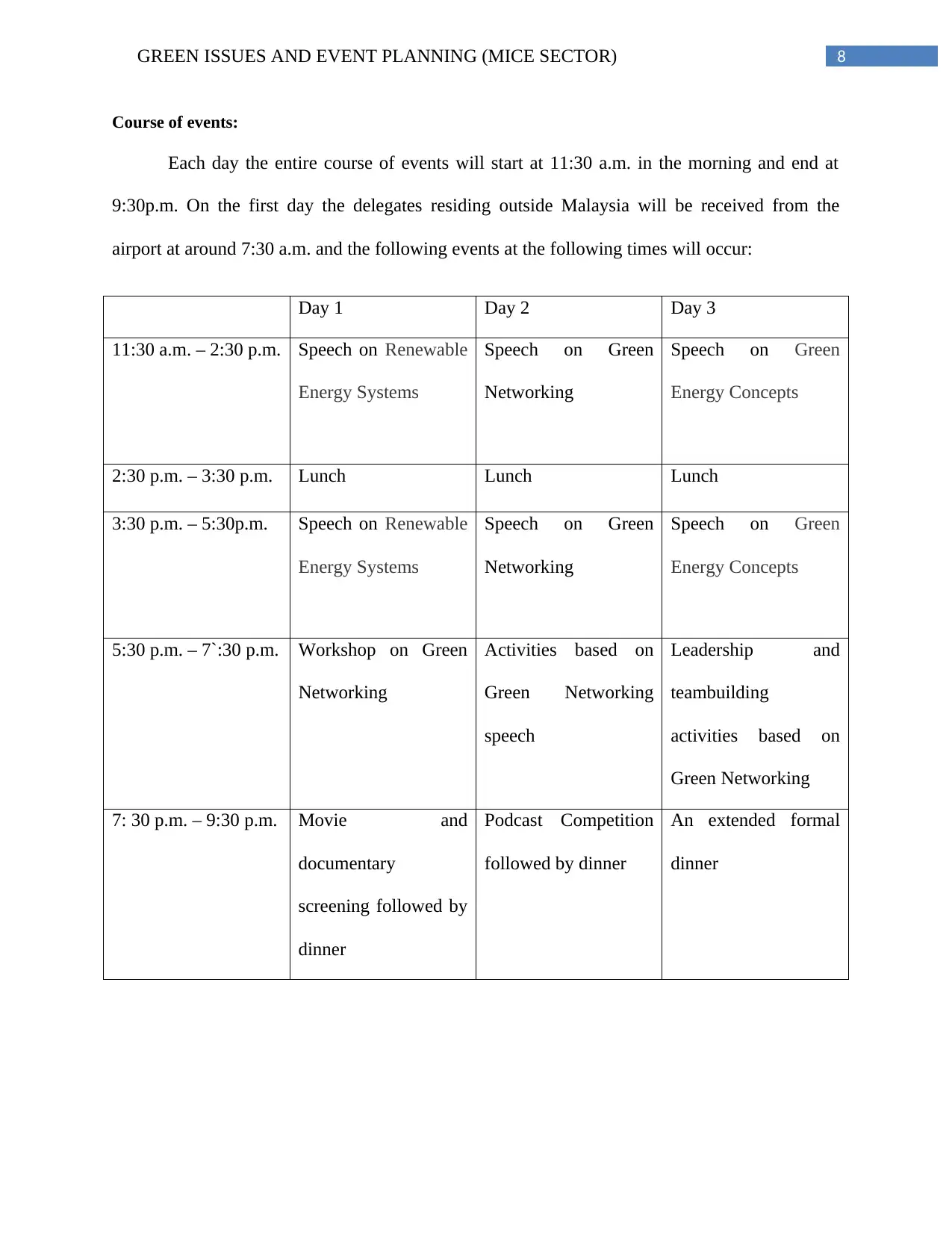
8GREEN ISSUES AND EVENT PLANNING (MICE SECTOR)
Course of events:
Each day the entire course of events will start at 11:30 a.m. in the morning and end at
9:30p.m. On the first day the delegates residing outside Malaysia will be received from the
airport at around 7:30 a.m. and the following events at the following times will occur:
Day 1 Day 2 Day 3
11:30 a.m. – 2:30 p.m. Speech on Renewable
Energy Systems
Speech on Green
Networking
Speech on Green
Energy Concepts
2:30 p.m. – 3:30 p.m. Lunch Lunch Lunch
3:30 p.m. – 5:30p.m. Speech on Renewable
Energy Systems
Speech on Green
Networking
Speech on Green
Energy Concepts
5:30 p.m. – 7`:30 p.m. Workshop on Green
Networking
Activities based on
Green Networking
speech
Leadership and
teambuilding
activities based on
Green Networking
7: 30 p.m. – 9:30 p.m. Movie and
documentary
screening followed by
dinner
Podcast Competition
followed by dinner
An extended formal
dinner
Course of events:
Each day the entire course of events will start at 11:30 a.m. in the morning and end at
9:30p.m. On the first day the delegates residing outside Malaysia will be received from the
airport at around 7:30 a.m. and the following events at the following times will occur:
Day 1 Day 2 Day 3
11:30 a.m. – 2:30 p.m. Speech on Renewable
Energy Systems
Speech on Green
Networking
Speech on Green
Energy Concepts
2:30 p.m. – 3:30 p.m. Lunch Lunch Lunch
3:30 p.m. – 5:30p.m. Speech on Renewable
Energy Systems
Speech on Green
Networking
Speech on Green
Energy Concepts
5:30 p.m. – 7`:30 p.m. Workshop on Green
Networking
Activities based on
Green Networking
speech
Leadership and
teambuilding
activities based on
Green Networking
7: 30 p.m. – 9:30 p.m. Movie and
documentary
screening followed by
dinner
Podcast Competition
followed by dinner
An extended formal
dinner
You're viewing a preview
Unlock full access by subscribing today!
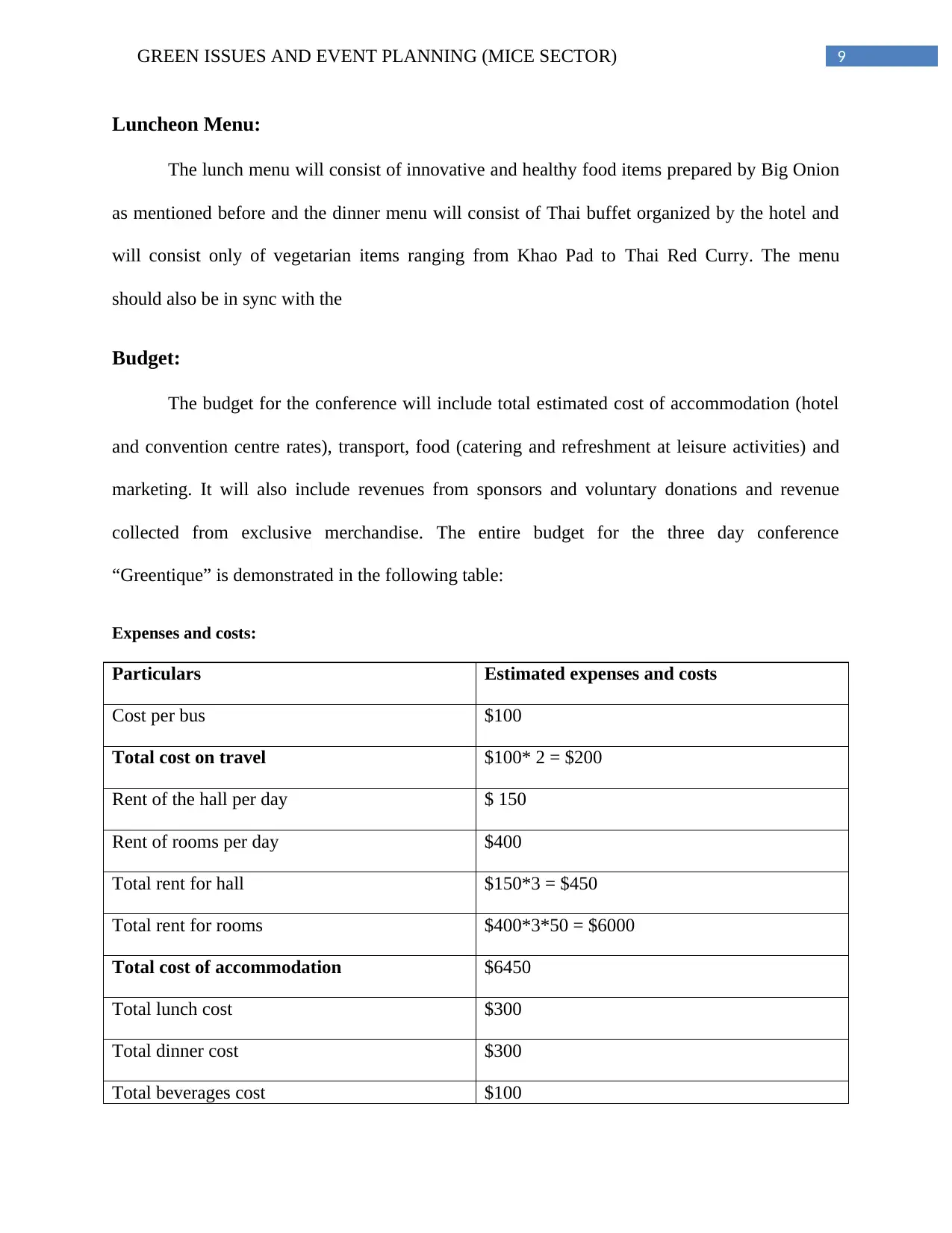
9GREEN ISSUES AND EVENT PLANNING (MICE SECTOR)
Luncheon Menu:
The lunch menu will consist of innovative and healthy food items prepared by Big Onion
as mentioned before and the dinner menu will consist of Thai buffet organized by the hotel and
will consist only of vegetarian items ranging from Khao Pad to Thai Red Curry. The menu
should also be in sync with the
Budget:
The budget for the conference will include total estimated cost of accommodation (hotel
and convention centre rates), transport, food (catering and refreshment at leisure activities) and
marketing. It will also include revenues from sponsors and voluntary donations and revenue
collected from exclusive merchandise. The entire budget for the three day conference
“Greentique” is demonstrated in the following table:
Expenses and costs:
Particulars Estimated expenses and costs
Cost per bus $100
Total cost on travel $100* 2 = $200
Rent of the hall per day $ 150
Rent of rooms per day $400
Total rent for hall $150*3 = $450
Total rent for rooms $400*3*50 = $6000
Total cost of accommodation $6450
Total lunch cost $300
Total dinner cost $300
Total beverages cost $100
Luncheon Menu:
The lunch menu will consist of innovative and healthy food items prepared by Big Onion
as mentioned before and the dinner menu will consist of Thai buffet organized by the hotel and
will consist only of vegetarian items ranging from Khao Pad to Thai Red Curry. The menu
should also be in sync with the
Budget:
The budget for the conference will include total estimated cost of accommodation (hotel
and convention centre rates), transport, food (catering and refreshment at leisure activities) and
marketing. It will also include revenues from sponsors and voluntary donations and revenue
collected from exclusive merchandise. The entire budget for the three day conference
“Greentique” is demonstrated in the following table:
Expenses and costs:
Particulars Estimated expenses and costs
Cost per bus $100
Total cost on travel $100* 2 = $200
Rent of the hall per day $ 150
Rent of rooms per day $400
Total rent for hall $150*3 = $450
Total rent for rooms $400*3*50 = $6000
Total cost of accommodation $6450
Total lunch cost $300
Total dinner cost $300
Total beverages cost $100
Paraphrase This Document
Need a fresh take? Get an instant paraphrase of this document with our AI Paraphraser
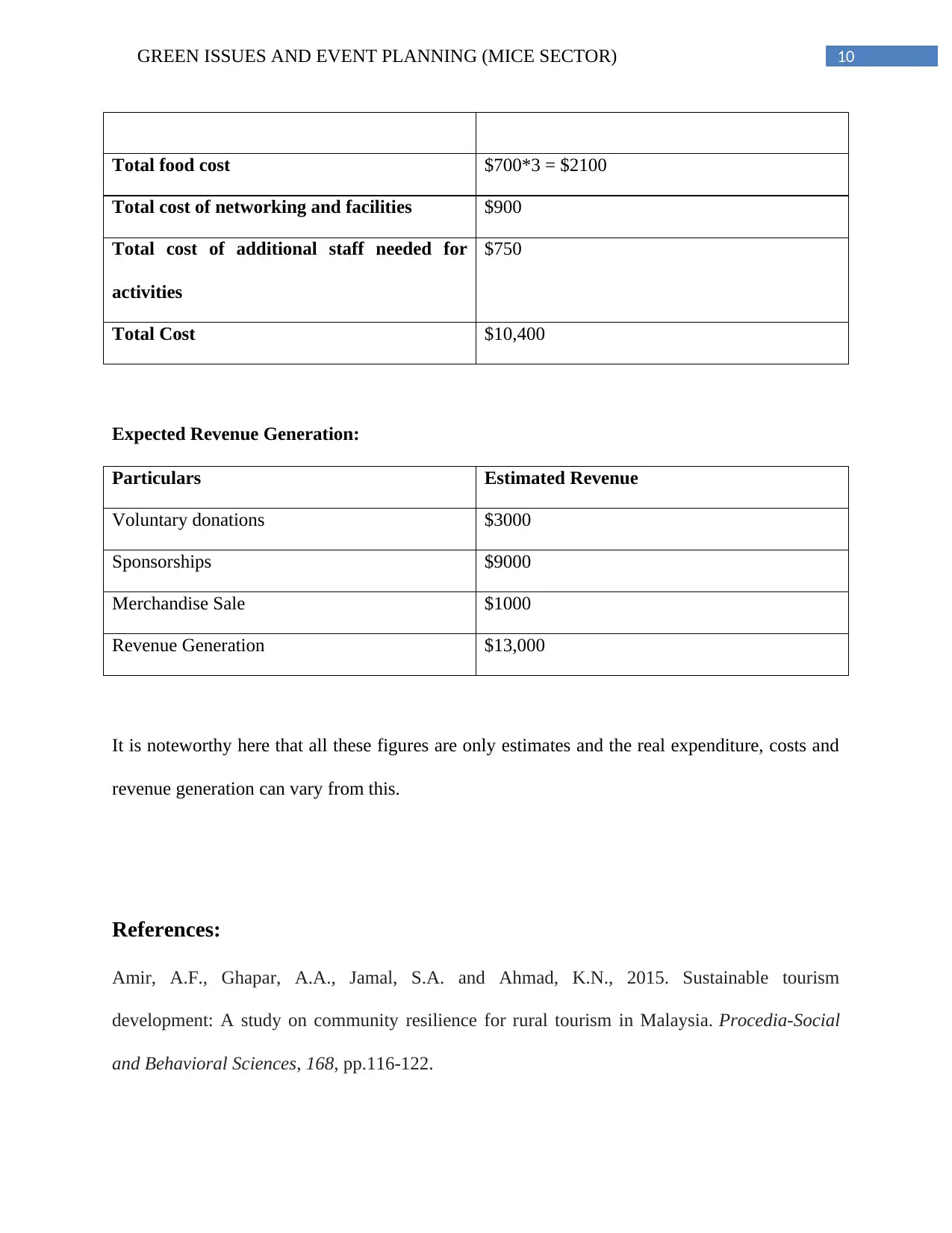
10GREEN ISSUES AND EVENT PLANNING (MICE SECTOR)
Total food cost $700*3 = $2100
Total cost of networking and facilities $900
Total cost of additional staff needed for
activities
$750
Total Cost $10,400
Expected Revenue Generation:
Particulars Estimated Revenue
Voluntary donations $3000
Sponsorships $9000
Merchandise Sale $1000
Revenue Generation $13,000
It is noteworthy here that all these figures are only estimates and the real expenditure, costs and
revenue generation can vary from this.
References:
Amir, A.F., Ghapar, A.A., Jamal, S.A. and Ahmad, K.N., 2015. Sustainable tourism
development: A study on community resilience for rural tourism in Malaysia. Procedia-Social
and Behavioral Sciences, 168, pp.116-122.
Total food cost $700*3 = $2100
Total cost of networking and facilities $900
Total cost of additional staff needed for
activities
$750
Total Cost $10,400
Expected Revenue Generation:
Particulars Estimated Revenue
Voluntary donations $3000
Sponsorships $9000
Merchandise Sale $1000
Revenue Generation $13,000
It is noteworthy here that all these figures are only estimates and the real expenditure, costs and
revenue generation can vary from this.
References:
Amir, A.F., Ghapar, A.A., Jamal, S.A. and Ahmad, K.N., 2015. Sustainable tourism
development: A study on community resilience for rural tourism in Malaysia. Procedia-Social
and Behavioral Sciences, 168, pp.116-122.
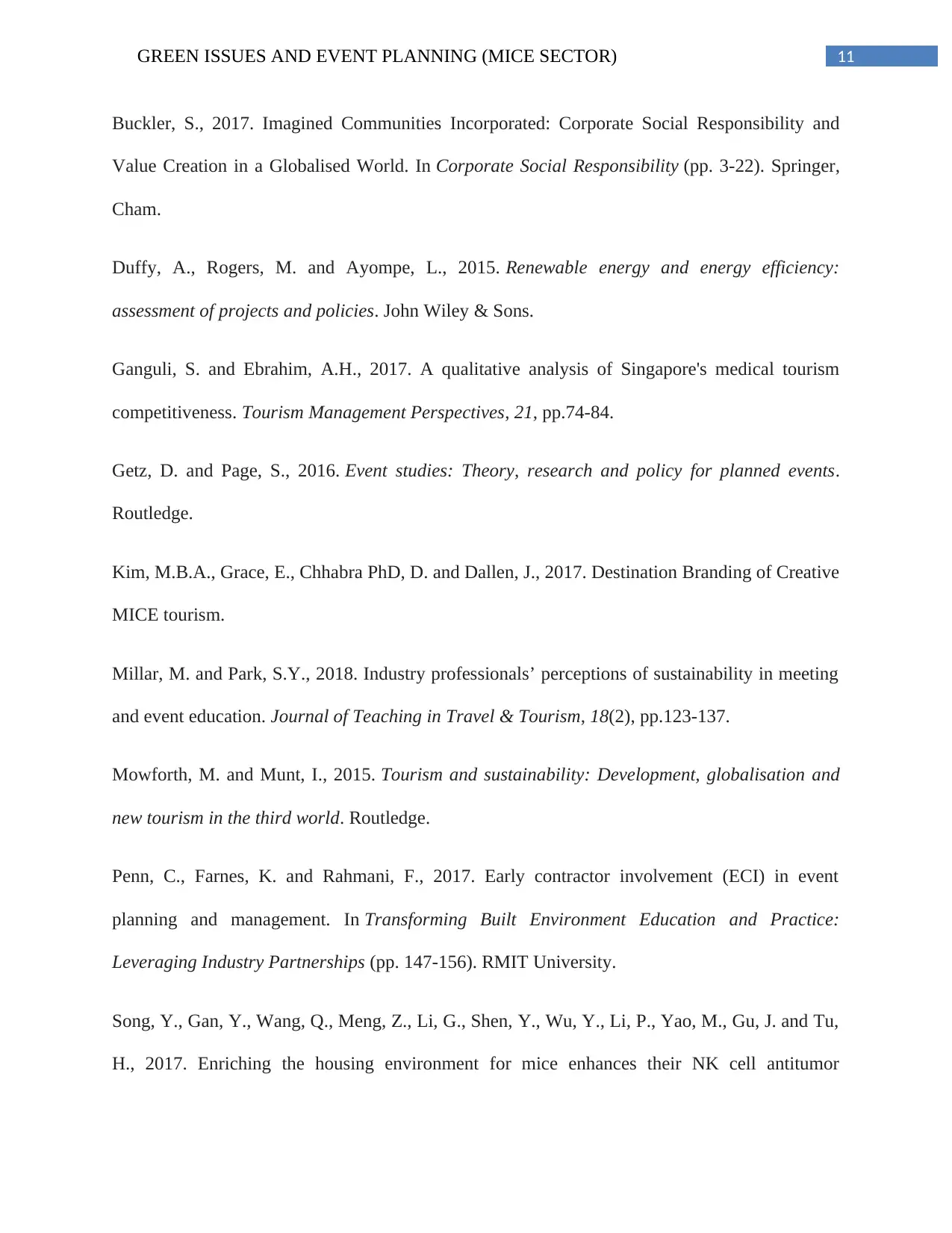
11GREEN ISSUES AND EVENT PLANNING (MICE SECTOR)
Buckler, S., 2017. Imagined Communities Incorporated: Corporate Social Responsibility and
Value Creation in a Globalised World. In Corporate Social Responsibility (pp. 3-22). Springer,
Cham.
Duffy, A., Rogers, M. and Ayompe, L., 2015. Renewable energy and energy efficiency:
assessment of projects and policies. John Wiley & Sons.
Ganguli, S. and Ebrahim, A.H., 2017. A qualitative analysis of Singapore's medical tourism
competitiveness. Tourism Management Perspectives, 21, pp.74-84.
Getz, D. and Page, S., 2016. Event studies: Theory, research and policy for planned events.
Routledge.
Kim, M.B.A., Grace, E., Chhabra PhD, D. and Dallen, J., 2017. Destination Branding of Creative
MICE tourism.
Millar, M. and Park, S.Y., 2018. Industry professionals’ perceptions of sustainability in meeting
and event education. Journal of Teaching in Travel & Tourism, 18(2), pp.123-137.
Mowforth, M. and Munt, I., 2015. Tourism and sustainability: Development, globalisation and
new tourism in the third world. Routledge.
Penn, C., Farnes, K. and Rahmani, F., 2017. Early contractor involvement (ECI) in event
planning and management. In Transforming Built Environment Education and Practice:
Leveraging Industry Partnerships (pp. 147-156). RMIT University.
Song, Y., Gan, Y., Wang, Q., Meng, Z., Li, G., Shen, Y., Wu, Y., Li, P., Yao, M., Gu, J. and Tu,
H., 2017. Enriching the housing environment for mice enhances their NK cell antitumor
Buckler, S., 2017. Imagined Communities Incorporated: Corporate Social Responsibility and
Value Creation in a Globalised World. In Corporate Social Responsibility (pp. 3-22). Springer,
Cham.
Duffy, A., Rogers, M. and Ayompe, L., 2015. Renewable energy and energy efficiency:
assessment of projects and policies. John Wiley & Sons.
Ganguli, S. and Ebrahim, A.H., 2017. A qualitative analysis of Singapore's medical tourism
competitiveness. Tourism Management Perspectives, 21, pp.74-84.
Getz, D. and Page, S., 2016. Event studies: Theory, research and policy for planned events.
Routledge.
Kim, M.B.A., Grace, E., Chhabra PhD, D. and Dallen, J., 2017. Destination Branding of Creative
MICE tourism.
Millar, M. and Park, S.Y., 2018. Industry professionals’ perceptions of sustainability in meeting
and event education. Journal of Teaching in Travel & Tourism, 18(2), pp.123-137.
Mowforth, M. and Munt, I., 2015. Tourism and sustainability: Development, globalisation and
new tourism in the third world. Routledge.
Penn, C., Farnes, K. and Rahmani, F., 2017. Early contractor involvement (ECI) in event
planning and management. In Transforming Built Environment Education and Practice:
Leveraging Industry Partnerships (pp. 147-156). RMIT University.
Song, Y., Gan, Y., Wang, Q., Meng, Z., Li, G., Shen, Y., Wu, Y., Li, P., Yao, M., Gu, J. and Tu,
H., 2017. Enriching the housing environment for mice enhances their NK cell antitumor
You're viewing a preview
Unlock full access by subscribing today!
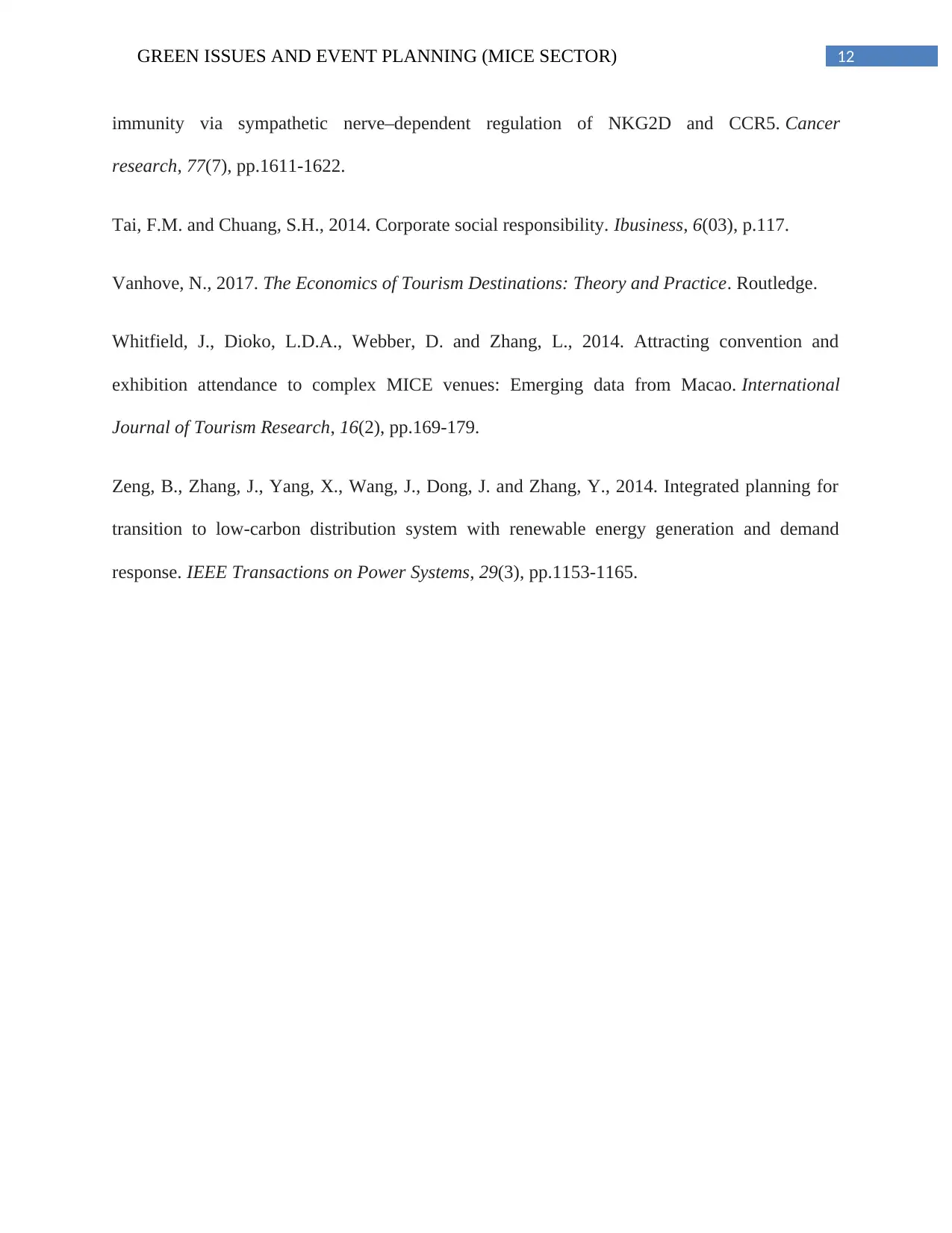
12GREEN ISSUES AND EVENT PLANNING (MICE SECTOR)
immunity via sympathetic nerve–dependent regulation of NKG2D and CCR5. Cancer
research, 77(7), pp.1611-1622.
Tai, F.M. and Chuang, S.H., 2014. Corporate social responsibility. Ibusiness, 6(03), p.117.
Vanhove, N., 2017. The Economics of Tourism Destinations: Theory and Practice. Routledge.
Whitfield, J., Dioko, L.D.A., Webber, D. and Zhang, L., 2014. Attracting convention and
exhibition attendance to complex MICE venues: Emerging data from Macao. International
Journal of Tourism Research, 16(2), pp.169-179.
Zeng, B., Zhang, J., Yang, X., Wang, J., Dong, J. and Zhang, Y., 2014. Integrated planning for
transition to low-carbon distribution system with renewable energy generation and demand
response. IEEE Transactions on Power Systems, 29(3), pp.1153-1165.
immunity via sympathetic nerve–dependent regulation of NKG2D and CCR5. Cancer
research, 77(7), pp.1611-1622.
Tai, F.M. and Chuang, S.H., 2014. Corporate social responsibility. Ibusiness, 6(03), p.117.
Vanhove, N., 2017. The Economics of Tourism Destinations: Theory and Practice. Routledge.
Whitfield, J., Dioko, L.D.A., Webber, D. and Zhang, L., 2014. Attracting convention and
exhibition attendance to complex MICE venues: Emerging data from Macao. International
Journal of Tourism Research, 16(2), pp.169-179.
Zeng, B., Zhang, J., Yang, X., Wang, J., Dong, J. and Zhang, Y., 2014. Integrated planning for
transition to low-carbon distribution system with renewable energy generation and demand
response. IEEE Transactions on Power Systems, 29(3), pp.1153-1165.
1 out of 13
Related Documents
Your All-in-One AI-Powered Toolkit for Academic Success.
+13062052269
info@desklib.com
Available 24*7 on WhatsApp / Email
![[object Object]](/_next/static/media/star-bottom.7253800d.svg)
Unlock your academic potential
© 2024 | Zucol Services PVT LTD | All rights reserved.





